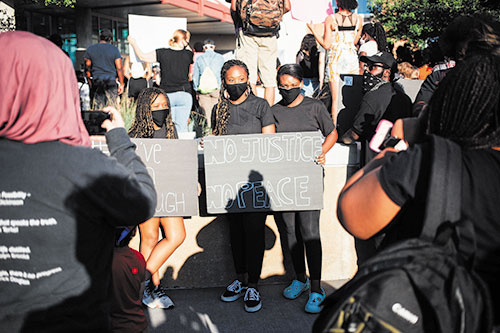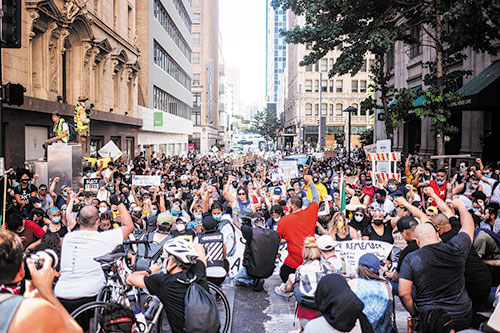Protest photos by Jordan Smith
Protests in the wake of George Floyd’s death continue. But with women leading the way, the violence has subsided
Steven Monacelli | Contributing Writer
In the past week following the widely-reported June 1 police attack on and mass arrest of protesters on Margaret Hunt Hill Bridge — in which Dallas police used tear-inducing gas canisters, rubber bullets and pepper bullets to subdue people taking part in a protest over the death of George Floyd — every single protest event in Dallas has been peaceful. And the vast majority of them have been led by black women and other women of color.
 This is a notable pattern, not just for the sake of highlighting the overwhelmingly peaceful nature of the past week of protests — even those that have explicitly sought to challenge the now-defunct Dallas curfew — but to draw a contrast to earlier events led by Dominique Alexander, head of NextGenActionNetwork, who faces allegations of domestic abuse.
This is a notable pattern, not just for the sake of highlighting the overwhelmingly peaceful nature of the past week of protests — even those that have explicitly sought to challenge the now-defunct Dallas curfew — but to draw a contrast to earlier events led by Dominique Alexander, head of NextGenActionNetwork, who faces allegations of domestic abuse.
My purpose here is not to investigate Alexander’s personal life, which has sparked some controversy over the past year. On the contrary, I am following the advice of various organizers on the ground to follow the real story: the growing number of people participating in entirely peaceful protest actions in Dallas.
 There is no lack of organizers. Furthermore, there is no need to try to tear down an organizer who is — in the eyes of movement leaders — already out of the picture. As one organizer said to me regarding Alexander, “He needs to take time to heal himself and his relationships. This is not about him.”
There is no lack of organizers. Furthermore, there is no need to try to tear down an organizer who is — in the eyes of movement leaders — already out of the picture. As one organizer said to me regarding Alexander, “He needs to take time to heal himself and his relationships. This is not about him.”
It is, instead, about shifting the focus.
From a journalist’s perspective
At Belo Park on Saturday, June 6, approximately 3,000 people gathered for an event hosted by the Dallas Alliance Against Racists & Political Repression. Just as two women of color were about to take the stage representing organizers, an older black man began yelling and arguing with some of the organizers near the sound booth. Many photo and video journalists present began to train their cameras on that drama as it unfolded. As I approached, I overheard a young organizer tell media, “This is a distraction y’all. You should be listening to them,” indicating the women taking the stage
 So I did just that. I walked away from the sideshow and instead focused my camera on the organizers, who then directly addressed Dallas Chief of Police Renee Hall, Mayor Eric Johnson and the Dallas City Council.
So I did just that. I walked away from the sideshow and instead focused my camera on the organizers, who then directly addressed Dallas Chief of Police Renee Hall, Mayor Eric Johnson and the Dallas City Council.
The female organizers spoke out against the police violence perpetrated against the protesters and directly challenged the claims made by Renee Hall.
“Chief Hall, let’s talk about one of your major lies. You and the media have run with this false narrative that before last Friday you hadn’t used tear gas in 30 years. That is an outright lie,” one of the women said. “I and others were there in 2018 when your police department shot tear gas at a group of peaceful protesters at the Botham Jean protest … . My 1-and-a-half-year-old son was tear gassed … . You are complicit and guilty of crimes against this city and those who visit it … . Resign!”
Speakers also challenged the “outside agitator” narrative pushed by Mayor Johnson, arguing that many who protest in Dallas may not live here but do work here every day. They demanded justice for all the peaceful protesters who had been subjected to police brutality in Dallas.
Too many journalists and media organizations fall into the trap of covering the drama. But most protests I cover are long, hot walks through the summer streets of Dallas. There is, without a doubt, energy, emotion and anger. But most of that, particularly the speeches of organizers themselves, rarely makes the nine o’clock news.
And that is why my crew is focusing completely on the peaceful events and why I am working to draw a parallel between the local female leadership of the Dallas protests and the broader, national and international trends that indicate women sharing power is essential to longstanding peace and prosperity.
The future is female
Research by Harvard Business School and Columbia Business School suggests that women are better at leading diverse countries. They tend to focus more on “inclusive” and “tolerant” governments, and their economies tend to grow faster.
From what we’ve seen on the ground in Dallas, women-led organizations have held uniformly peaceful events and have seen their event turnout grow the fastest.
A number of other research findings buttress the idea that women-led organizations are essential to the success of the anti-racist movement — research most recently addressing how female-led countries have better handled the COVID-19 epidemic, and more generally, a broad range of studies suggesting that female empowerment is central to all other forms of social and economic development.
But let’s remember that it has only been two weeks since George Floyd died at the hands of a Minneapolis police officer and protests erupted around the country and even the world.
This iteration of the anti-racism movement is still in its early days — remember, the Montgomery Bus Boycott lasted a little over a year — and despite the increasing triple digit temperatures and notably decreasing police presence, protesters show no sign of letting up. The women leading this growing movement in Dallas have a long road ahead of them, and they know it. As they have said, “This is a marathon, not a sprint!”

















If you really wanted to do some journalistic research, find out why a black baby is 5 TIMES more likely to be aborted than a white baby. Facts are facts, and if you don’t believe me, then do your job and research it.
I am actually aware of this issue! The following paragraph captures much of what I have learned in my own research.
“Black women are not alone in having disproportionately high unintended pregnancy and abortion rates. The abortion rate among Hispanic women, for example, although not as high as the rate among black women, is double the rate among whites. Hispanics also have a higher level of unintended pregnancy than white women. Black women’s unintended pregnancy rates are the highest of all. These higher unintended pregnancy rates reflect the particular difficulties that many women in minority communities face in accessing high-quality contraceptive services and in using their chosen method of birth control consistently and effectively over long periods of time. Moreover, these realities must be seen in a larger context in which significant racial and ethnic disparities persist for a wide range of health outcomes, from diabetes to heart disease to breast and cervical cancer to sexually transmitted infections (STI), including HIV. Abortion rates have been declining in the United States for a quarter of a century, from a high of 29.3 per 1,000 women aged 15–44 in 1981 to an historic low (post-Roe v. Wade) of 19.4 in 2005. The overall number of abortions has been falling too, dropping to 1.2 million in 2005. Currently, about one-third of all abortions are obtained by white women, and 37% are obtained by black women.”
https://www.guttmacher.org/gpr/2008/08/abortion-and-women-color-bigger-picture